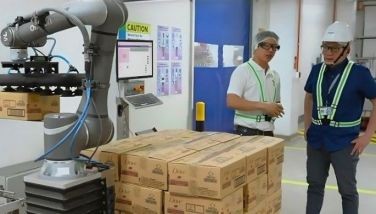Slip sliding away towards the jewel of the Huangpu
My wife and I were in Chicago when we got the message from a friend in Hong Kong — would we like to join a three-day cruise from Hong Kong to Shanghai? I replied that I would be broke by the time we got to Hong Kong. We were in Chicago for the tail end of the production of what is surely the most expensive piece of paper ever wrought — our son’s diploma. As if this production wasn’t costly enough, we were embarking on a month of travel at mostly ruinously expensive hotels. Then my friend gave me an offer my Ilocano soul could not resist — the trip was free, courtesy of the Costa Cruise Lines.
Carnival Cruise Corporation, the biggest cruise ship owner and operator in the world, had decided to venture from the Mediterranean to the China Sea. A ship from Carnival’s Costa Cruise brand, the Costa Allegra, was going to be stationed in Shanghai. Its maiden voyage would have it sailing from Italy to Hong Kong; pick up a few invited passengers; take them to Shanghai; wine, dine and entertain them en route; and then cap it all with an extravaganza to celebrate Costa’s entry into China. And we’d just been invited to be part of it!
 1930s era buildings on the Bund: China has one foot firmly in the past.
1930s era buildings on the Bund: China has one foot firmly in the past. I must say that, once one boards a cruise ship, the immediate impulse is to leave every care ashore and wallow in indulgence on board. And a cruise ship’s design is geared towards the passenger doing precisely that. Even if it is a relatively small ship, the Costa Allegra has everything one can think of — a three-level atrium, two restaurants, three bars, a theater, a ballroom, a disco, a meeting room, a card room, a library and Internet center, a Flamenco club, two swimming pools, three Jacuzzis, a 215-meter jogging track, a fitness center, a beauty center and spa, a casino and, of course, a cornucopia of alimentation and drink.
The group of invited guests — 150 in all, housed in a ship that could accommodate 800 — was a conglomeration of social and business types. Many had known each other long before the Costa Allegra set off for Shanghai and therefore it was with a shared feeling of bonhomie and exhilaration that everyone embarked on this voyage. When we finally shoved off from the Ocean Terminal and sailed majestically through Hong Kong’s beautiful but shrinking harbor, the passengers were giddy with excitement. Unfortunately, the giddiness and exhilaration evaporated when we had our first dinner on board. The sea was so rough and the ship was pitching and rolling so much that dinner plates were sliding across the tables and guests were stumbling from one table to another. Not a few of them went green around the gills, left and were not heard from again until the afternoon of the following day. Fortunately the next two days brought in calmer seas and everyone could enjoy the trip without a barf bag in tow.
 The author and his wife, Chingbee Cuenca, being welcomed into the Costa Allegra on gala night.
The author and his wife, Chingbee Cuenca, being welcomed into the Costa Allegra on gala night. The next two days came and went without further incident. We were all left free to wander about the ship, exercise, swim, have massages, sunbathe, take ballroom dancing lessons, shop, gamble, eat, drink and be merry and, most of all, relax. Every night we were treated to a Las Vegas-style show in the ship’s theater except on the last night when the dancers bared their breasts and it became more Moulin Rouge than Las Vegas. When we finally arrived in Shanghai, Costa Cruises hosted an extravaganza produced by Valerio Festi, who also produced the opening ceremony of the Turin Winter Olympics. The show was spectacular — part Cirque du Soleil and part Federico Fellini.
The Carnival Cruise Corporation does not waste any time. The day after we arrived, the Costa Allegra left for its inaugural cruise to Cheju Island and Nagasaki. It had been pre-sold long before our arrival, no doubt due to a very affordable introductory rate of less than $1,000 per head for a five-day cruise, all inclusive. Unfortunately the Philippines, despite being an island nation with beautiful beaches to offer, does not figure at all in the equation except as a provider of manpower — such is our lot. China and its market of over a billion people is the Costa Cruise Lines’ target; all other markets pale in comparison.
 The view from the Observatory tower in Pudong: The other foot of China is firmly in the present.
The view from the Observatory tower in Pudong: The other foot of China is firmly in the present. Having landed in Shanghai with a day to spare before we were flown back to Hong Kong, a group of us took in the sights, had lunch and went shopping. Having been to the mainland several times before and having had the chance to see both its ancient and its modern aspects, I couldn’t help but marvel at the contradiction that is China. It is, after all, a communist country with a roaringly successful capitalist economy. The country has one foot firmly in the past (the Chinese tend to treat ancient history as having just happened yesterday) and the other foot firmly in the present. Shanghai, China’s business and financial capital is a gleaming example of the success (so far) of this contradiction. It has over a thousand skyscrapers, fashionable developments like Xintiandi, glamorous name-brand boutiques and cutting edge restaurants, all of which can be had at First World prices. The Bund, Shanghai’s most famous landmark and a symbol of its rapacious pre-Communist past and its humiliation by the gweilos, has been spruced up and beautifully lit. Across the Huangpu River, the Pudong district has been transformed into what China hopes to be the rival of the world’s financial centers.
 The façade of the restaurant owned by Jackie Chan in Xintiandi: Glam dining
The façade of the restaurant owned by Jackie Chan in Xintiandi: Glam dining Unlike Beijing, one would be hard put to find historical landmarks in this city; they come few and far between. This city exists for one thing alone — to make money. Lots of it. Anyone who has ever lived in a world capital will feel at home in Shanghai. It is becoming increasingly like New York. Nevertheless, it is a First World city in a Third World country. Once in a while, though, if one’s eyes are sharp enough, one can see the third world intruding on this shining world capital — like the two granddads strolling along Nanjing Road in their pyjamas or the guy setting up his lean-to in one corner of this postmodern metropolis wearing nothing but precariously loose briefs.
On a previous trip to Shanghai, I had occasion to take the magnetic levitation train from Pudong to the airport. This train utilizes cutting-edge magnetic technology to make the train levitate above its tracks, thereby eliminating friction and allowing a top speed of 431 kilometers per hour. Onboard, I felt a tinge of despair. While China is hurtling towards the 21st century on the wings of a levitating train, we hapless Filipinos are stuck in a decrepit train station whose rusting trains are going nowhere because the tracks have been stolen.




















